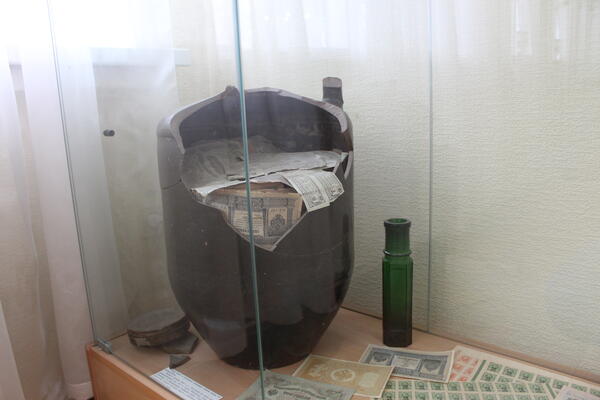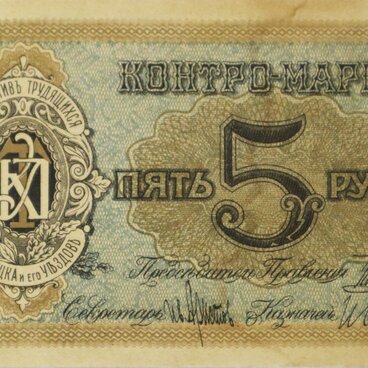The Lipetsk Regional Museum of Local Lore houses more than twenty treasures of coins and paper banknotes, which were found in different years on the territory of the Lipetsk region. Each of the treasures has its own history, including the one that was discovered in the city of Chaplygin (formerly Ranenburg) in the arched passage of the house that belonged to the merchant Mikhailov. The finds are on display in the hall of the numismatics collection.
On November 27, 1969, the Ministry of Internal Affairs of the USSR received a statement from a pensioner who said that his wife’s aunt, Anna Dmitrievna Mikhailova, had lived in his family since 1932. She had been married to the son of a wealthy Ranenburg merchant Mikhailov. The merchant sold paints, leather and other goods. Shortly before her death, the woman said that soon after the October Revolution, the merchant Mikhailov himself, his wife and son decided to save the money they had so that it would not be confiscated and buried it in the ground.
Before the revolution, Ranenburg was considered an important trading center. The annual commercial and industrial turnover was more than 2 million rubles, and there were about 280 enterprises. Every week, on Wednesdays and Saturdays, there was a market trade in the city.
Using the description of the Mikhailov’s house, researchers found it at 10 Sovetskaya Street. During the search for the treasure, the researchers used a mine detector. As a result of excavations at a depth of 60 cm, paper money and bonds of the state treasury issued by a pre-revolutionary Russian bank were found in a glass jar with a cork (the jar was not preserved), and gold coins of royal minting were found nearby in a tetrahedral bottle. In addition, a clay vessel with paper money was also found.
In December 1969, the treasure with a large clay vessel and a green glass bottle was transferred to the Lipetsk Museum of Local Lore. The exception was made for the gold coins — only a few of them ended up in the museum, the rest, as was customary at that time, were sent to Moscow.
The Mikhailovs were unable to use their savings. According to local old-timers, in the 1920s and 1930s, the department of the State Political Administration under the NKVD was located in this house, so the merchant’s relatives did not have the opportunity to take the treasure.
On November 27, 1969, the Ministry of Internal Affairs of the USSR received a statement from a pensioner who said that his wife’s aunt, Anna Dmitrievna Mikhailova, had lived in his family since 1932. She had been married to the son of a wealthy Ranenburg merchant Mikhailov. The merchant sold paints, leather and other goods. Shortly before her death, the woman said that soon after the October Revolution, the merchant Mikhailov himself, his wife and son decided to save the money they had so that it would not be confiscated and buried it in the ground.
Before the revolution, Ranenburg was considered an important trading center. The annual commercial and industrial turnover was more than 2 million rubles, and there were about 280 enterprises. Every week, on Wednesdays and Saturdays, there was a market trade in the city.
Using the description of the Mikhailov’s house, researchers found it at 10 Sovetskaya Street. During the search for the treasure, the researchers used a mine detector. As a result of excavations at a depth of 60 cm, paper money and bonds of the state treasury issued by a pre-revolutionary Russian bank were found in a glass jar with a cork (the jar was not preserved), and gold coins of royal minting were found nearby in a tetrahedral bottle. In addition, a clay vessel with paper money was also found.
In December 1969, the treasure with a large clay vessel and a green glass bottle was transferred to the Lipetsk Museum of Local Lore. The exception was made for the gold coins — only a few of them ended up in the museum, the rest, as was customary at that time, were sent to Moscow.
The Mikhailovs were unable to use their savings. According to local old-timers, in the 1920s and 1930s, the department of the State Political Administration under the NKVD was located in this house, so the merchant’s relatives did not have the opportunity to take the treasure.



